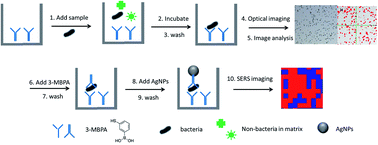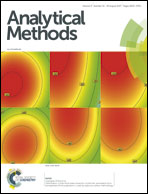Innovative sandwich assay with dual optical and SERS sensing mechanisms for bacterial detection†
Abstract
The increased incidence of food pathogen outbreaks placed a new emphasis on the requirement of a rapid, sensitive, and reliable detection method for pathogens in food samples. Surface-enhanced Raman spectroscopy (SERS) is a technique that tremendously enhances the weak Raman scattering of an analyte by using a metallic nano-substrate. Herein, we developed an innovative SERS sandwich assay which is based on 3-mercaptophenylboronic acid (3-MPBA) as a capturer and reporter for the detection of bacteria. Using Salmonella enterica and Listeria monocytogenes as model bacteria, we have identified a unique bacterial SERS signal upon the interaction between the captured bacteria, 3-MBPA and silver nanoparticles (AgNPs), which was used as the base for reliable detection of bacteria using SERS mapping. Both optical and chemical (SERS mapping) imaging were used as mechanisms for bacterial detection and quantification. Our assay achieved sensitive and reliable detection of as low as 102 CFU mL−1 for Salmonella with great capability for quantification. The total analytical time for optical detection is 1.25 hours and for SERS imaging is 3 hours. Our assay represents an innovative platform for rapid, sensitive and reliable detection of total bacteria for an array of industrial applications.



 Please wait while we load your content...
Please wait while we load your content...